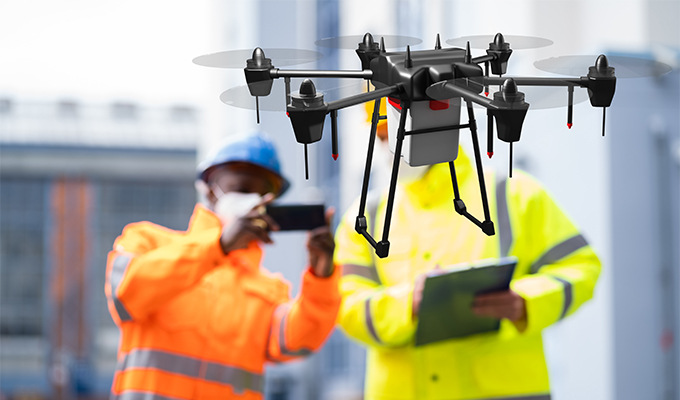By Emily Newton
Despite significant strides in workplace safety over the past few decades, construction remains one of the most dangerous professions in America.
Drones have emerged as one possible solution to construction’s safety problem. These unmanned aerial vehicles (UAVs) can survey unsafe site areas, sparing workers from exposure to threats like toxic gas, unstable structures, and other dangerous environmental conditions.
Still, drones can come with their own safety risks. Crashes and near-misses can sometimes lead to injury, distract workers, or even damage site structures. Contractors can use drones to improve jobsite safety, even when a project is ongoing — but only with the proper practices and precautions.
Benefits of Drones in Construction Safety
Drone technology has become increasingly popular over the past few years due to the safety benefits of UAVs. Construction drones often provide significant benefits in situations where a human worker could complete the task, but doing so would put them at serious risk.
For example, drones can be an effective tool when monitoring construction progress along a highway or in a high-traffic area. Using a drone here would reduce or eliminate the risk of a worker being struck by a vehicle.
When access to a site by human workers may be costly or dangerous — for example, skyscrapers, bridges, towers, and similarly tall structures — these drones can prevent the need for human workers and the risk of a fall.
Contractors can also use these drones to streamline site safety tasks. For example, one business may use drones to monitor a site. Contractors can use aerial photography and 3D scans that the drone produces to quickly create progress reports of large sites.
Potential Hazards Posed by Safety Drones
While using drones on an active jobsite, contractors should remain aware of the safety risks drones can pose. If a drone crashes, flies near the ground, or flies near a structure, it runs the risk of colliding with or nearly missing site workers.
Research on the safety risks posed by construction site drones has found that UAVs pose three significant categories of risk for workers: “collision with properties, collision with humans, and distraction.”
The high-speed rotating blades of a drone pose risks for workers. Failure of essential drone equipment, like the sudden overheating of a battery, can lead to a drone crash, posing similar risks.
Specific site conditions may make drone failures more likely. Damaged power lines, for example, could electrify drones in flight, damaging the sensitive onboard electronics and potentially overheating the drone battery.
Because particular electrical cables may be more prone to damage than others, like Romex cables compared to MC cables, contractor decisions like the choice of site cabling can have a significant impact on drone safety.
A drone on-site may also distract site workers, making common construction accidents like falls and slips more likely. In some scenarios, drones may also obscure workers’ vision, making the operation of critical equipment like cranes and lifts harder.
UAVs will likely pose the most risk in dense areas with large numbers of workers. Complex environments with features that pose risks to the UAV — like overhead power lines — are also likely to increase the danger that drones may pose.
Best Practices for Drone Operation on Live Jobsites
Mitigating these risks will require the right strategies.
Skilled drone operators will likely make a significant difference. Contractors should prioritize working with experienced drone operators, especially those who have experience navigating around common risks, like unstable structures and the potential for electromagnetic interference.
Contractors should always fully brief drone operators on jobsite conditions, with particular attention paid to outlining potential safety threats.
Similarly, contractors should prepare for situations where drones may need special protection. For example, electromagnetic drone shielding may be necessary on jobsites where electromagnetic interference could make a drone more challenging to pilot.
Contractors should also inform workers on the jobsite ahead of time if drones will be present. This communication will keep workers in the loop and reduce the risk that drone activities distract them while at work.
Scheduling drone operations for hours where fewer workers will be on-site could help reduce potential safety risks.
Contractors may also consider investing in safety equipment that can make the operation of drones near workers much safer. Bumpcages, for example, are aftermarket drone upgrades that surround rotors with plastic or metal guards. These guards help to prevent a rotor blade from striking a worker as a drone passes by.
Safe Operation of Drones on Active Construction Jobsites
Along with other breakthroughs and innovations, drones are helping to make some of the most dangerous worksites much safer. However, they can also generate new safety risks. Contractors who choose to use drone inspection to improve jobsite safety should be aware of construction drone best practices. These practices will help them get the most out of drones without creating new risks for workers on-site.
When working with drone operators to improve site safety, communication with workers and the proper safety preparations — like the use of bumpcages — will help minimize potential hazards.
about the author
Emily Newton is an industrial writer who specializes in covering how technology is disrupting industrial sectors. She’s also the editor-in-chief of Revolutionized where she covers innovations in industry, construction and more. Subscribe to her newsletter for the latest articles from Emily.


